
Enterprise risk management is a systematic approach to managing risks within an organization. It helps businesses identify, assess, manage, and control their risks. The goal of enterprise risk management is to improve the quality of decisions and actions taken by the organization.
Enterprise risk management is a proactive approach to managing risks. It requires a business to develop strategies to mitigate or eliminate risks, monitor and measure the effectiveness of these strategies and finally communicate the findings to stakeholders.
Why Companies Need to Integrate Enterprise Risk Management
Enterprise risk management is an important part of every company’s operations. Sadly, only 36% of companies have a recognized enterprise risk management program. Companies are prone to cybersecurity, reputational, regulatory, financial, operational, and strategic risks. Every business will benefit from this holistic approach to identifying such risks. Here are some benefits of enterprise risk management for your business.
1. Create Awareness
From its definition, enterprise risk management creates awareness about your organization’s risks and enhances your ability to respond effectively. Ideally, ERM provides oversight because it incorporates all areas in which your business is exposed to risks. The information enterprise risk management provides enables you to respond to these potential threats appropriately.
2. Increased Compliance With Regulatory Requirements
Every business is expected to comply with the legal and regulatory requirements through reporting and other requirements. As such, enterprise risk management provides sufficient data to show your compliance and assure stakeholders that all potential threats are effectively managed and controlled to minimize breaching regulatory compliance requirements.
3. Provides Increased Confidence to Achieve Your Goals
Risks have great potential to derail goal accomplishment. And because enterprise risk management helps you identify and manage risks, your confidence in achieving your company’s objectives increases greatly. ERM shows you all potential curveballs, helping you take necessary measures to mitigate them.
4. Provides Clear Risk Oversight
Enterprise risk management is an efficient way to showcase your risk profile before the company’s board and leadership team. With customizable boards and clickable reports, you can access real-time information on risks and opportunities to provide useful data to the stakeholders. Enterprise risk management helps you present the risk profile to the company’s leadership in a way they value and demonstrate how the risk can affect the organization.
The Elements of ERM
The Committee of Sponsoring Organizations (COSO) has established a framework for internal controls to be incorporated into business practices to ensure that the business operates transparently according to the established industry standards. Here are the elements of enterprise risk management according to COSO.
1. Internal Environment
46% of CEOs feel that the current business climate has only aggravated companies’ risks. A company’s culture and atmosphere are known as the internal environment. It helps you set the company’s risk appetite precedence and the management’s philosophy regarding the occurrence of risks. The internal environment can be set by the board or upper management and then communicated within the company, although it mostly reflects the employees’ actions.
2. Setting Objectives
Enterprise risk management requires a company to set objectives that support its goals and mission and are aligned with its risk appetite. For instance, you can set extensive strategic plans but make a provision for internal and external risks related to these goals. So, you can hire more regulatory staff to handle the new expansion areas new to you as a way of aligning your goals with the associated risks.
3. Identifying Events
Enterprise risk management involves identifying positive and negative events in a business. Positive events have a great impact, while negative events can be detrimental to a company’s operations. Through the guidance of ERM, you receive recommendations to help you identify high-risk events that cause operational or strategic risks.
4. Assessing Risks
The enterprise risk management framework guides you in assessing potential risks through understanding their likelihood and financial impact on your business. This includes direct risks and residual risks. The framework encourages you to quantify risks by assessing the dollar impact and overall occurrence change.
5. Responding to Risks
The enterprise risk management framework guides you to respond to risk by avoiding, reducing, sharing, and accepting risk. Depending on the nature of the risks, you can choose one of these ways to respond.
6. Control Activities
These comprise all the actions you take to create procedures and policies that ensure operations continue while mitigating risk. These activities are internal controls that are either preventative to stop the occurrence of risky activities or defective to identify the occurrence of a risky activity.
7. Monitoring
ERM encourages you to have an internal or external auditor audit your practices and policies to determine actual performance over what the policy documents indicate. This includes analyzing data, getting feedback, and informing the leadership of unknown and unprotected risks. This information helps a company assess its risk environment and pivot as necessary.
Conclusion
At its core, enterprise risk management involves managing risks throughout the organization’s lifecycle. This means understanding the potential impact of events and taking action before they occur. Therefore, enterprise risk management aims to reduce the likelihood of negative outcomes from external threats or internal errors. As a result, ERM is a key component of a company’s overall strategy and should be integrated into its culture.
1813 Views












